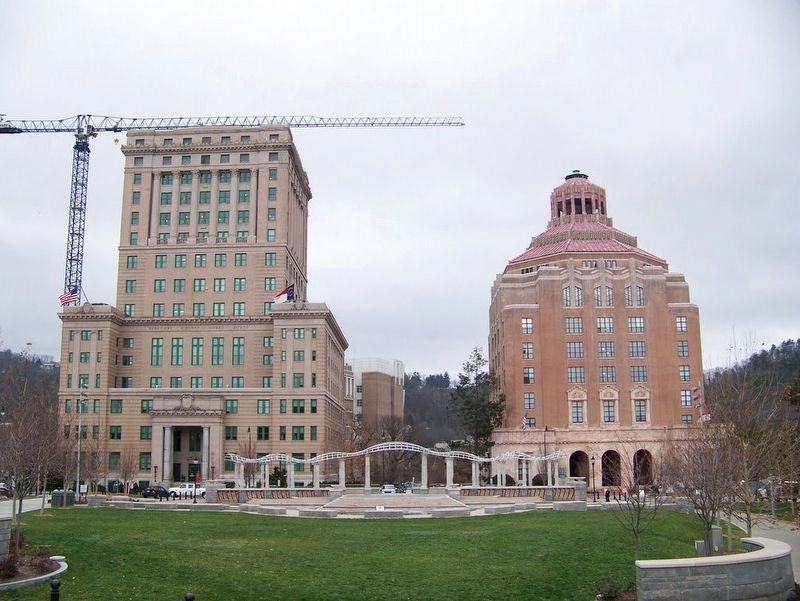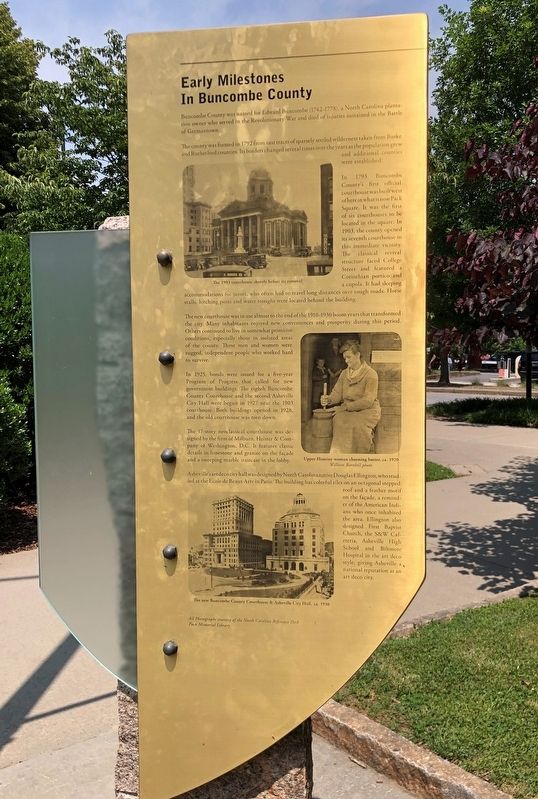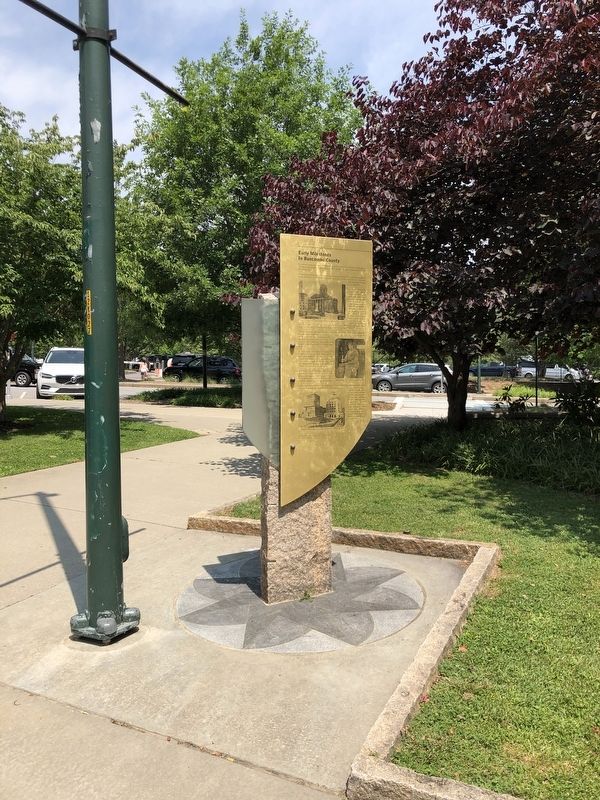Downtown in Asheville in Buncombe County, North Carolina — The American South (South Atlantic)
Early Milestones in Buncombe County
Inscription.
Buncombe County was named for Edward Buncombe (1742-1778), a North Carolina plantation owner who served in the Revolutionary War and died of injuries sustained in the Battle of Germantown.
The county was formed in 1792 from vast tracts of sparsely settled wilderness taken from Burke and Rutherford counties. Its borders changed several times over the years as the population grew and additional counties were established.
In 1793 Buncombe County's first official courthouse was built west of here in what is now Pack Square. It was the first of six courthouses to be located in the square. In 1903, the county opened its seventh courthouse in this immediate vicinity. The Classical-revival structure faced College Street and featured a Corinthian portico and a cupola. It had sleeping accommodations for jurors, who often had to travel long distances over rough roads. Horse stalls, hitching posts and water troughs were located behind the building.
The new courthouse was in use almost to the end of the 1910-1930 boom years that transformed the city. Many inhabitants enjoyed new conveniences and prosperity during this period. Others continued to live in somewhat primitive conditions, especially those in isolated areas of the county. These men and women were rugged, independent people who worked hard to survive.
In 1925, bonds were issued for a five-year Program of Progress that called for new government buildings. The eighth Buncombe County Courthouse and the second Asheville City Hall were begun in 1927 near the 1903 courthouse. Both buildings opened in 1928, and the old courthouse was torn down.
The 17-story Neoclassical courthouse was designed by the firm of Milburn, Heister & Company of Washington, D.C. It features classic details in limestone and granite on the facade and a sweeping marble staircase in the lobby.
Asheville's Art Deco City Hall was designed by North Carolina native Douglas Ellington, who studied at the Ecole de Beaux Arts in Paris. The building has colorful tiles on an octagonal stepped roof and a feather motif on the facade, a reminder of the American Indians who once inhabited the area. Ellington also designed First Baptist Church, the S&W Cafeteria, Asheville High School and Biltmore Hospital in the Art Deco style, giving Asheville a national reputation as an Art Deco city.
[Captions (top to bottom)]
• The 1903 courthouse shortly before its removal.
• Upper Hominy woman churning butter, ca. 1920. William Barnhill photo
• The new Buncombe County Courthouse & Asheville City Hall, ca. 1930.
All photographs courtesy of the North Carolina Reference Desk, Pack Memorial Library
Topics. This historical marker is listed in these topic lists: Architecture • Political Subdivisions. A significant historical year for this entry is 1792.
Location. 35° 35.759′ N, 82° 32.955′ W. Marker is in Asheville, North Carolina, in Buncombe County. It is in Downtown. Marker is at the intersection of Court Plaza and College Street (Alternate U.S. 74), on the right when traveling south on Court Plaza. Touch for map. Marker is at or near this postal address: 80 Court Plaza, Asheville NC 28801, United States of America. Touch for directions.
Other nearby markers. At least 8 other markers are within walking distance of this marker. Shindig on the Green (within shouting distance of this marker); Confederate Armory (within shouting distance of this marker); Buncombe County Court House (within shouting distance of this marker); Thomas Wolfe (within shouting distance of this marker); Western North Carolina Veterans Memorial (within shouting distance of this marker); In Remembrance of Col. Robert K. Morgan (within shouting distance of this marker); War with Spain (within shouting distance of this marker); Ellington's Dream (within shouting distance of this marker). Touch for a list and map of all markers in Asheville.
Also see . . . Edward Buncombe. In 1774, as the independence movement of the Thirteen Colonies gathered steam, he took a leading role

Upstateherd via Wikimedia Commons (CC BY-SA 4.0), December 20, 2012
3. Buncombe County County & Asheville City Hall
Both buildings were constructed simultaneously and opened in 1928.
Credits. This page was last revised on July 28, 2023. It was originally submitted on July 28, 2023, by Duane and Tracy Marsteller of Murfreesboro, Tennessee. This page has been viewed 76 times since then and 26 times this year. Photos: 1, 2, 3. submitted on July 28, 2023, by Duane and Tracy Marsteller of Murfreesboro, Tennessee.

